Robert
Battle for the the Baltic Islands Triumph Of the Imperial German Navy by Gary Staff The usual stor...

For your Wargamer, Toy soldier collector, MiniFig collector, military history nut. Reviews, interviews, Model Making, AARs and books!
Battle for the Baltic Islands: Triumph of the Imperial German Navy by Gary Staff
Robert
Azul probably needs no introduction. Since its release in 2017, it has proven to be one of those unicorn-games that has managed to cros...
For your Wargamer, Toy soldier collector, MiniFig collector, military history nut. Reviews, interviews, Model Making, AARs and books!
Azul
Azul probably needs no introduction. Since its release in 2017, it has proven to be one of those unicorn-games that has managed to cross over, from hobby games, into more mainstream gaming. Last Christmas my Sister, who is not a gamer and who I haven't seen in years (she lives in a different continent), called me up to talk about Azul which she had just played.
It is a competitive abstract game that is quick to teach and has a surprising amount of depth and it will give gamers and non-gamers alike plenty to chew on. It also looks beautiful on the table and if anything, plays too quickly, i.e. it is over before I want it to be over, two or three more rounds would always be welcome.
You can watch my quick unboxing of Azul below:
Gameplay
All players are building a mosaic on their own player board from a collective pool of tiles in the centre of the table. Available tiles all start in a number of 'factories' that are placed in between all players. You must take all tiles of the same pattern from a factory, any tiles that didn't match your pattern are discarded to the centre of the table to form a common pool of tiles.You could just play this game concentrating on your own board, but the tile draw mechanism also allows you to jeopardise your opponent's best choices in a deliciously mean fashion. Of course, a casual gamer is probably not going to look for those 'take that' opportunities and will have a lovely time building their own mosaic on their own player board, albeit having to work through some unexpectedly tough decisions.
Those tough decisions, in all likelihood, have come from the experienced gamer or keen Azul-player at the table who may be looking for as many opportunities to minimise their opponents' choices.
This game rewards either play style, if not through an abundance of victories (I've not figured out a consistently good strategy) but in playing experience and fun. And after all, why do we play and obsess over these cardboard and plastic pieces whose intrinsic value is so little? I know for me, it's because of the experiences and fun that I have when playing with a friend or group of friends, the memories that are made and recalled...
When you've taken one pattern of tile from a factory or the centre, you place them on a pattern line, which has one to five spaces available. Tiles can only be placed on empty lines, or lines that have the same tile in already and empty spaces available. If you can't place them on a free pattern line, then they drop to the floor line. Any tiles on your floor line will cause negative points at the end of a round.
Any abstract game is always going to struggle with theme, but Azul probably has more of a theme than any abstract I've played. It's still fairly loose, but your actions and the overall look of the game reflect the process of building a mosaic work of art nicely.
Scoring happens after all tiles have been taken from the centre. It is simply a matter of taking a tile from a complete pattern line and placing it into your mosaic. When you do this you add up how many orthogonally contiguous tiles are touching it, and you count the placed tile in both the horizontal and vertical direction. If the placed tile is not adjacent to any other tile, it will score 1 point; if it is at the centre of a row and column then it will score a maximum of 10 points. ( I have never managed this)
The end of the game is triggered when one person has one complete row. During my first game of this, my casual game group and I all raced to be the first to complete a row thinking that was a good thing. We did not appreciate that the end game scoring doesn't reward finishing the game. Players get far more bonus points from completing rows and using 5 tiles of the same colour in their mosaic. end thinking that was a good thing... However, after their 2nd and third consecutive plays of it, we were all a bit savvier and trying to score more points, over finishing the game.
This endgame condition balances the gameplay nicely. When you're in the lead, you're pushing to finish the game as quickly as possible, which will probably cause you to lose scoring opportunities making you lose points relative to the other players. If you're trailing, you are able to engineer, at least if there are three other savvy players around the table much harder tile draw decisions for the leading player whilst maximising your own score. The player interaction, despite all playing to their own board, is high.
Components
The tiles are glorious and the art, although simple geometric patterns are again, evocative of the theme. The box looks and feels fantastic and it comes with a well-though-out insert. Unfortunately, my player boards are bowed which helps them to spin round like a record very easily.Criticisms
A complete game is anywhere from five complete rounds to an average of six to eight rounds. For me, the game is over just a little too soon. I know this is normally the sign of a tight and balanced game and in general this a good thing. However, I find I am enjoying myself so much that I don't necessarily care that I may not be winning and just want to build a nicer pattern and have more turns in which to do so... I think I may be an artist at heart.Conclusion
Azul is a heart-warming game, in the same vein as Patchwork and fully deserves its place as a modern 'classic', or at least, a soon-to-be modern classic. It is accessible for any type of gamer and although there's no direct conflict, there are certainly opportunities to mess with your opponents and it's this trait, being able to accommodate different play styles, that makes it appeal to any type of gamer. For me, it sits firmly in the filler category, taking about 40 minutes to play. I could see this easily becoming a firm family-favourite at holiday gatherings.I think I am correct in saying that every single game store will have a copy of this game on their shelves and you can use this link http://www.findyourgamestore.co.uk/ to find your nearest store in the UK.
Publisher: Plan B Games
Website: https://www.planbgames.com/azul
Players: 2 - 4
Designer: Michal Kiesling
Playing time: 30 - 45 mins
SHERMAN LEADER from DAN VERSSEN GAMES A good starting point would be with my earlier review of Tiger Leader , as clearly there...
For your Wargamer, Toy soldier collector, MiniFig collector, military history nut. Reviews, interviews, Model Making, AARs and books!
SHERMAN LEADER
The terrain overlays are slightly less glossy; marginally, I think that I prefer them, yet prefer the older terrain art work for the snow-bound tiles of the Bulge Campaign. By historical necessity, some of the campaigns included in the previous game cannot be part of this package when focusing on the American side of WWII. North Africa, Italy, the Normandy Campaign and Germany obviously feature, but in come three Pacific campaigns: the Philippines 1942, Saipan 1944 and Okinawa 1945. To accompany the new Pacific Campaigns, we have new jungle terrain and a separate Battalion Deck for the Japanese. These are identified on the front of the cards by appropriate symbols and pictures.
The Leader cards feature artwork in muted colours, while the illustrations on the cards with scenes and equipment from WWII remain the black and white type found in Tiger Leader. We already know that some people liked them and some didn't - I did. So, presumably there's still the difference in taste now - and I still like them. No surprises there!
As before, oodles of high quality counters and cards, all very familiar, as is the whole sequence of play. So, for those of you familiar with the Leader series and especially with Tiger Leader you may wish to skip over the next sections.
In game terms, the combination of Campaign and Objective is most significant in producing SO [Special Option] points, which are the purchasing power for the troops you stock your campaign with and to buy a few sundry benefits. Your units range from basic infantry, including machine gun and mortar teams, through armour and light armour to anti-tank, half-tracks and artillery. You can also buy trucks and scouts, but these don't appear as counters on your map. Instead, trucks help in reducing the SO cost of attacking enemy battalions in specific locations on the Tactical Display Sheet, while scouts allow you to extend the standard number of 5 turns in a battle. Both can be absolutely essential buys at times.
These will be the total number of enemy Battalions that you will face over the course of a typical campaign which will last from 3 to 5 weeks. Each week, you will make the choice of which of these Battalions you will fight and the number of them that you destroy by the end of the campaign will determine your level of success.
Commands & Colors Ancients Expansions 2-3 Reprint by GMT Games Commands & Colors Ancients was designed...

For your Wargamer, Toy soldier collector, MiniFig collector, military history nut. Reviews, interviews, Model Making, AARs and books!
Commands & Colors Ancients Expansions 2-3 Reprint by GMT Games
 |
| This is actually a picture of the first printing. The only thing different on the newer box is that it says "Second Reprint" |
- 3" Box
- 457 red, green, gray and black blocks
- 1 sheet of terrain tiles
- 7 sheets of labels
- 2 reference cards
- 1 combined rule and scenario book
Freedom! is an asymmetric card driven wargame that models a relatively unknown yet surprisingly important siege between the Ottoman Empi...

For your Wargamer, Toy soldier collector, MiniFig collector, military history nut. Reviews, interviews, Model Making, AARs and books!
Freedom! a Kickstarter preview
Freedom! is an asymmetric card driven wargame that models a relatively unknown yet surprisingly important siege between the Ottoman Empire and the Greek rebel insurgents in the city of Messolonghi. The siege in question is actually the third siege between greek insurgents demanding their freedom from the Ottoman Empire during the early 19th century, none of which I knew anything about prior to receiving this game.
The designer Vangelis Bagiartakis has written a fascinating designer's diary on bgg that is well worth a read if you're interested in the development or history of this game. https://www.boardgamegeek.com/freedom-designer-diary
Gameplay
Watch my rules overview to get an idea of how the game plays. However, there are far more professional efforts which I will link to below.Players control the two opposing forces and fight out the siege over 6 rounds. In each round, 7 cards will be played for a maximum total of 42 actions per player per game. The Imperial player, however, could end the game early if they manage to infiltrate just one of their units into the forts on the wall or into the Southern City, effectively assaulting the city from the Lagoon.
| Ready to go |
I've played three full games of this and in each, they were all well balanced between my opponent and me. The only aberration I experienced was during the very first replenishment of the first game, my plea to the government, as the insurgent player was successful, (I rolled an 11) and had one point in my plea track which made my roll 12, i.e. a successful plea. This allowed my rebels to storm into the lead early on, but I eventually lost the game as my supplies completely dried up in the second period.
| An early success for the rebels, unlucky for some |
Like other card-driven games, cards are either played for the event or the action points. I should highlight, which for some reason, it got lost on the editing floor, that when a player plays a card with their opponent's event, the opponent, on their next turn, can discard a card from their hand to have the previously played event happen. This is an excellent innovation on the standard cdg mechanic, which serves to make the game that bit more accessible and forgiving. This ability to 'play' your own event previously used by your opponent is unique and I would not be surprised to see the mechanic 'borrowed' by other designers for future projects.
There are layers of games, area control, tight economic engine, and well balanced between both forces. Integrated into a whole that is engaging for both sides. The insurgents are just as much fun to play as the Imperials.
| A selection of all components |
Components
I have been sent a prototype and I am stunned by how good the art currently is. I am reluctant to criticise a prototype's components but I would like there to be unique art for most of the cards. In many cases, the same art is used albeit the card events are similar. I hope they can commission the same artist to do many more pieces for the game.The graphic design is a little dark in some places and the clouds across the board feel a bit redundant. The overall look of the board is fantastic and I'm sure will only get better as the game raises development funds through Kickstarter.
| I'd love there to be unique art everywhere |
Criticisms
The biggest criticism I have, and it's probably more justified to level this at our hobby rather than the game, is its theme, it is quite obscure, and serves a niche within a niche. This may serve to hinder the game's adoption amongst potential backers which would be a shame. I think wargamers who may well be very interested in the theme could be but put off by the 'simpler than Twilight Struggle' tag, (let's not discuss whether TS is a wargame or not...). Conversely, casual gamers who would be enticed by a siege game set in the Crusades, or even Leningrad which subjectively are far more accessible, may be put off by a siege in a city they've never heard of, and in a war they don't know.Conclusion
Any game that I enjoy playing and at the same time helps me to learn something new is, in my opinion, excellent. This game has that property in spades, I knew nothing about the siege of Messolonghi before hearing about this game, and now I know some of the major events of the siege itself from reading the card texts and have also wished for some Messolonghi-related books to learn some more.| These are glorious, more please... |
The underlying mechanics of this game are solid and as polished as any published title from any game publisher. The rulebook itself needs some work and the graphic design across most components could do with a little attention (I do love the art though). Freedom! is coming to Kickstarter at exactly the right time to secure some more funds to push it through the final stages of its design and I salute Phalanx Games for picking this up and giving us the opportunity to support it. I will follow the campaign with interest.
This project is live on Kickstarter right now, visit the project at https://www.kickstarter.com/projects/phalanxgames/freedom
These comments are all based from a prototype version of the game which is subject to change.
A preview from the designer himself:
Bonding with Board Games preview:
Detailed review from the Players Aid:
Publisher: Phalanx Games
Players: 2...
Designer: Vangelis Bagiartakis
Playing time: 2 - 3 hours
Horse & Musket Volume III: Crucible of War by Hollandspiele This is the third volume in the Horse & Mus...

For your Wargamer, Toy soldier collector, MiniFig collector, military history nut. Reviews, interviews, Model Making, AARs and books!
Horse & Musket Volume III: Crucible of War by Hollandspiele
Delayed Bayonet Charge
Movement Cadence marching
Artillery Fire Vs. Charges
These are the Optional Rules that can be used with Volume III:
Nationality Rules (use these from Volume III, and not the ones that came with the earlier games)
Square
Volley Fire
This is the sequence of play:
1. Player A rolls and determines random action points available to the command action points and stored action points for his total.
2. Player A spends his action points one at a time and performs allowable actions in any order he wishes.
3. Check victory
4. Player B rolls and determines random action points available to the command action points and stored action points for his total.
5. Player B spends his action points one at a time and performs allowable actions in any order he wishes.
6. Check victory
7. End turn - move turn marker ahead one space on the turn record chart and go to Step 1.
As you can see, the game play adds the fog of war to both sides with the random action point rolls. The player must also consider when and where to actually spend theses points. Do you wait and see how your defense is holding up on this turn, or do you start your counter-attack now? Like all great wargames the Horse & Musket series does a stellar job of putting the player in the shoes of the generals from this time period. The game also has enough chrome to make you believe you are fighting in the 18th century and not a stamped out WWII era game with different names for the units.
The leaders Montcalm, Wolfe, Friedrich der Grosse, Daun, and the battles of Leuthen, Kolin, Minden are all here along with a great many more. To see what I mean about the minimal approach, let us look at the Battle of Leuthen. This battle was one of the larger ones from this time. The Prussians have only eight pieces on the board, not counting leaders. The Austrians have a total of thirteen counters that you to have to order around like a good cardboard general. So, just like all of Hollandspiele's games the player can concentrate on his strategy, and not his manual dexterity. The battles of the Prussians against the Russians are my favorites.
Hollandspiele is a relatively new company, but it already has a large catalog of games for many tastes, from straight wargames to political simulations. They have quickly become one of my favorite publishers and a big thanks to them for letting me review this volume of Horse & Musket.
Here are the links to the other volumes:
https://hollandspiele.com/products/horse-musket-dawn-of-an-era
https://hollandspiele.com/products/horse-musket-sport-of-kings
Robert
Battlestar Galactica: Deadlock released all the way back in 2017, and since then it has received a series of updates in the form of bot...

For your Wargamer, Toy soldier collector, MiniFig collector, military history nut. Reviews, interviews, Model Making, AARs and books!
Battlestar Galactica: Deadlock - Season One in Review
Battlestar Galactica: Deadlock released all the way back in 2017, and since then it has received a series of updates in the form of both free patches and paid DLC. Developed by Black Lab Games, and published by prolific strategy game outfit Slitherine, Deadlock exceeded my own expectations by a great deal. I feared it would be a low budget, overly simple strategy game trying to cash in on the BSG name. But no, it was really quite good and I enjoyed it a lot, as you can see from my original review. Deadlock had not just a solid tactical layer with tense, WEGO space combat, it also had an immersive strategic layer that tied all the battles together. The only thing you could really knock the base game for was that it was a little light on content. The core was good, but there were only so many missions, and only so many ships to play with. We've now had a string of DLC and updates released to solve that issue.
The first major DLC for Deadlock is the one that is a must have in my opinion. It integrates all of its new content smoothly into the existing campaign, making for a richer overall experience. This DLC features an 8 mission story campaign which you play alongside the normal story missions. Anyone who has watched BSG knows that politics plays a central role in the story and drives a great deal of internal conflict for the humans. The Twelve Colonies of Man rarely agree about anything, even in the midst of a war. The Broken Alliance campaign, as the name suggests, focuses on the internal strife and intrigue which plagues humanity throughout the First Cylon War.
The Broken Alliance also adds four more new ships (two for each side) and a new squadron type for each side. The new ships add even more tactical options to the game. The Celestra resupply ship, for example, has little firepower potential on its own, but it can provide extra ammo for other ships mid-battle. Even more helpful is its ability to repair a section of armor on a friendly ship in combat. Each ship has separate armor sections for each side, top, and bottom. Lose a section of armor and now that ship becomes less useful, as you can't risk exposing an unarmored section for long. With the Celestra around you can patch things up and get a warship back in the fight. You can even use this offensively, hardening the nose of a Battlestar as it goes head on against an enemy group.
Endurance Update
Around the same time as the Broken Alliance came out, the game received a big free patch. This patch did some balancing, made the UI better, and generally polished the game. The best new feature was adding persistent damage to ships between battles, and visibly showing battle scars on ships after they took some hits. The persistent damage adds another layer of strategy to the game, as now you must spend resources to get ships back to full health. This seems like something that should have been in the game from the start, but I'm glad they added it in as a free update.
Anabasis
The next DLC for the game added an entire new mode, which was initially received with mixed opinions, but has since been balanced and polished a bit to make for a better experience. The new mode Operation Anabasis tells the story of a colonial fleet sent out on a deep strike mission against a Cylon base. Things go topsy-turvy as usual, and the fleet must flee back to Caprica, Cylons in hot pursuit the entire way. These mode obviously draws directly on the plot of the BSG show, in a good way. Your fleet starts out strong, but includes many civilian ships you must try to protect through battle after battle. You can repair your ships if they survive a fight, but that's about it. Each jump brings with it a random new set of bonuses and penalties to deal with. Your final performance is measured by how many ships you get back to Caprica safely, if you get there at all. While the mode is standalone, it does feature characters from the main storyline, and ties in with the overall plot of "Season One."
While the new survival mode is separate from the main campaign gameplay, the new DLC includes plenty of new content for it. Several new types of munitions are available that are far more interesting than the standard missiles and rockets of the base game. The EMP Generator lets you pull off that Star Trek-esque move from the BSG pilot, in which a ship winds up its generators to release an electromagnetic pulse, which damages any Cylons venturing too near. The Cylons also get some new toys, so watch out!
Another addition from this DLC is a dozen new types of side missions that can pop up during a regular campaign. These aren't just new maps (though there are new maps), but completely new types of objectives to accomplish.
Sin and Sacrifice
The just released, final DLC of Season One. Sin and Sacrifice extends the story of Deadlock beyond the conclusion of the original campaign and the Anabasis mission. The Cylons have been beaten back, but of course the big bad is still out there, ready to launch a fresh attack on the twelve colonies. You can either jump straight to this campaign with a pre-built late game fleet, or carry over your own fleets from the base campaign. I didn't have enough time to make it through the entire campaign just yet, but what I've seen so far is great stuff. Big battles between late game bruisers are the order of the day. There is plenty of new variety in what you are trying to do each mission as well, besides blowing apart as many toasters as you can, as usual. The two new ships added to the game reflect this idea. The humans get the Heracles, a new heavy offensive ship that is literally covered in gun turrets. It doesn't get any munition slots, but it can blast away at an entire Cylon fleet all at once. The Cylons get a new fighter support ship, which can repair their fighter squadrons mid battle and boost their performance. That's nothing to sneeze at when late game fleets are hauling around a half-dozen or more fighter squadrons at the least.
The other big, really cool addition to the game that Sin and Sacrifice brings is additional radio chatter. Previously, your ships had little voice lines announcing important things like missiles being launched or ships taking hull damage, but there were only so many of them, and they always sounded the same. Now, however, a ton (1100+ in fact) of great bits of radio chatter have been added into the background of a fight. You'll here plenty of utterances of "Frakkers!" and "Blast those toasters!" and every thing else you would expect from the BSG world. This adds so much flavor to the game and really increases the immersion as you watch the battles play out.
Veterancy Update
Another free update, which just came out along with Sin and Sacrifice, the Veterancy update adds a significant new feature to the game: the ability for individual ships to gain XP and "level up" over time. In the base game, you have fleet commanders who gain levels and unlock new abilities. The ships, however, never changed, no matter how many battles they survived or enemies they destroyed. That's all different now, as ships can level up and become more deadly over time. I really love this addition, as now you can really latch on to your early ships that hang around through a dozen battles and become your aces. Losing one, of course, will sting badly as you can't just crank out another veteran warship in a couple turns.
In addition to what I've listed here, the game has also been polished a great deal from when it was released. The game looks, sounds, and plays better than ever before. If you pick up the game, along with all the DLC, you'll be looking at paying a AAA game price, but you will be getting a very good, rich experience. Each DLC expands on the story and content of the original game, and I think each one is worth a purchase. All of them together make for a meaty game that you can sink a lot of hours into. As a big fan of the show, I'm really happy that such a worthy game was finally created.
Calling it Season 1 implies that there will be a Season 2, and the developers have confirmed that fact over on the forums. I look forward to seeing what else is added to the game!
BSG: Deadlock is available on PC, PS4 and XBOX One
Battlestar Galactica - Starship Battles Starter Set by Ares Games I did watch most episodes when BG was o...

For your Wargamer, Toy soldier collector, MiniFig collector, military history nut. Reviews, interviews, Model Making, AARs and books!
Battlestar Galactica - Starship Battles Starter Set by Ares Games
- Rulebook
- 1 Scenario Booklet
- 4 Spaceships with Gaming Bases
- 4 Control Panels
- Maneuver decks
- Pilot Cards
- Spaceship Cards
- Special Cards
- Rulers
- 2 Dice
- Counters, Tokens and Markers
The game is set up to have you up and shooting in no time. The Quick Start Rules start on page six of the rulebook and go to page twelve. For such a complex thing as warfare between starships in the vacuum of space, the rules are easy and elegant. The starships are treated just like WWI or WWII fighters, meaning that you have to aim your ship at the enemy in order to score a hit. There are no smart munitions to worry about. Nothing that can lock on and track you. The steps that you go through in the quick start rules are:
 |
| Cylon Raider |
"I'm raving about this game anywhere and everywhere I can, but admittedly I feel like Zarathustra come down from the mountain trying to convince people of the coming of the Uberspiel."





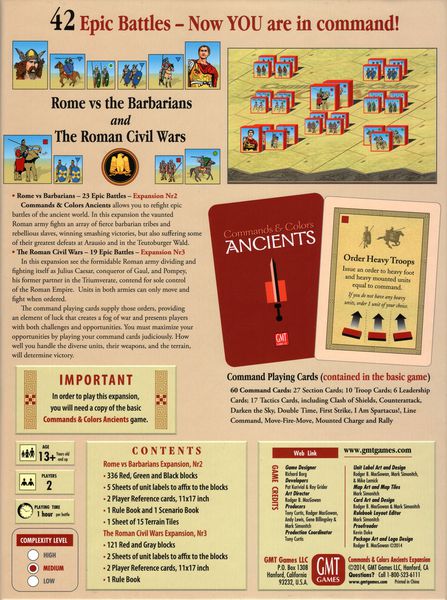
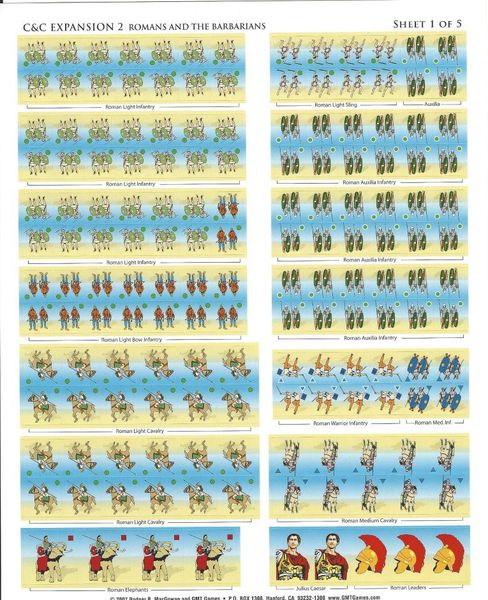







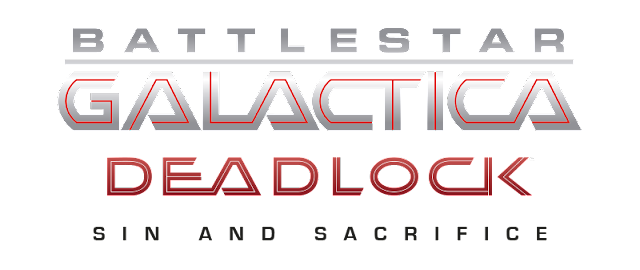

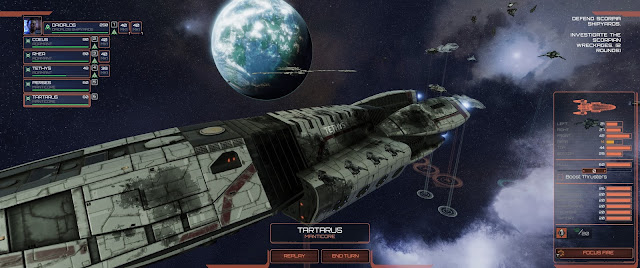
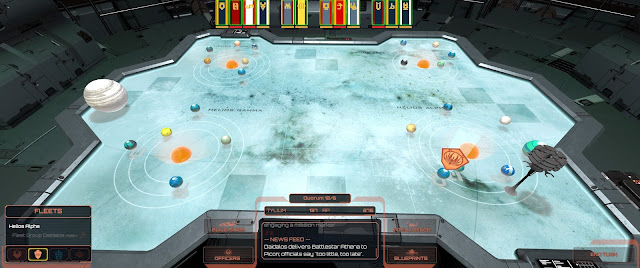
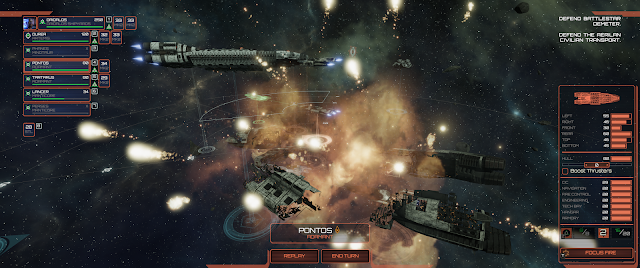








Follow Us